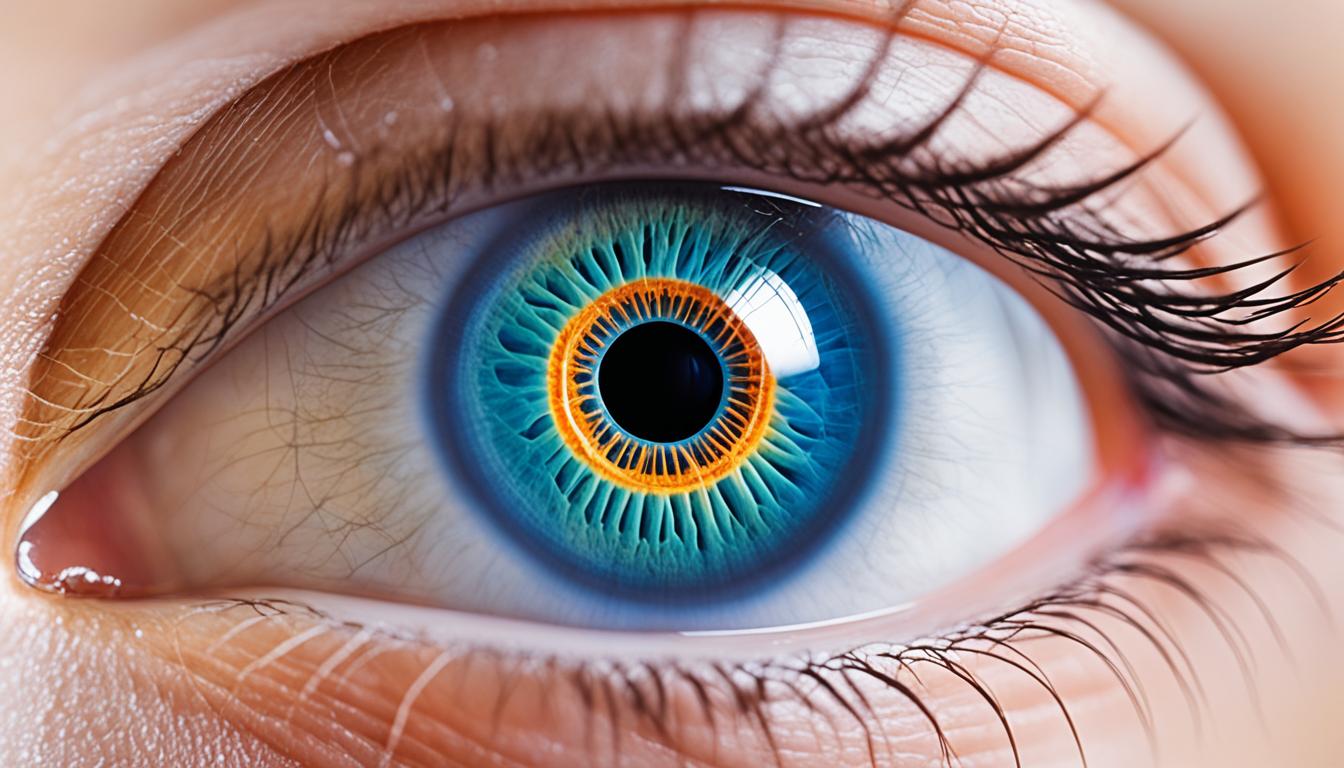Keratoconus is a disease that makes your cornea thin and your vision blurry. It’s common across all age groups. We’re not exactly sure what causes it, but genes and the environment might be involved.
Doctors usually diagnose it with a detailed eye exam, which can include special tests like corneal topography. You can manage keratoconus with corneal crosslinking, special lenses, and surgery if it’s bad. But nowadays, scientists are looking into using stem cell treatments to help the cornea heal in keratoconus patients.
Key Takeaways:
- Keratoconus is a progressive eye disease characterized by corneal thinning and vision distortion.
- Both genetic and environmental factors are believed to contribute to the development of keratoconus.
- Diagnosis of keratoconus involves a comprehensive eye examination, including corneal topography and corneal tomography.
- Treatment options for keratoconus include corneal crosslinking, contact lenses, and corneal transplant.
- Stem cell therapy is an emerging treatment option for corneal regeneration in keratoconus patients.
Symptoms and Diagnosis of Keratoconus
Keratoconus is a complex eye condition. It causes issues like blurred or distorted vision. People with it might also find bright lights bother them. Their glasses prescription may need changes often. These problems can make daily life much harder.
It takes a special eye exam to diagnose keratoconus. An experienced eye doctor is needed for this. Corneal topography and tomography are key tests. They show the cornea’s shape, thickness, and curve. This info helps find and check keratoconus.
Corneal Topography: Mapping Corneal Curvature
Corneal topography uses a painless imaging method. It maps the cornea’s shape in detail. This is crucial for finding keratoconus. It shows eye doctors any unusual shapes. With this map, doctors can spot early signs and choose the best treatment.
Corneal Tomography: Assessing Corneal Thickness and Shape
Another important test is corneal tomography. It measures the cornea’s thickness and shape very accurately. These details help eye doctors understand the cornea’s health. They use this to look for keratoconus signs. Then, they decide the treatment that’s right for each patient.
These tests, corneal topography and tonography, are vital for finding and evaluating keratoconus. Early detection and regular checks with these tools are crucial. They help make a good plan to treat keratoconus. This is how people keep their eyesight as healthy as possible.
Keep reading to find out what treatments are available for keratoconus in the next part.
Treatment Options for Keratoconus
The treatment for keratoconus depends on how bad it is. There are several ways to treat it. Let’s look at the main options:
1. Corneal Crosslinking
For those with mild to moderate keratoconus, corneal crosslinking is a go-to. Riboflavin (vitamin B2) eye drops are applied. Then the cornea gets UV light. This makes the collagen fibers in the eye stronger, which can stop the problem from getting worse.
2. Contact Lenses
Contact lenses work well for many with keratoconus. They help by making your vision sharper. RGP or scleral lenses are usually best for this. They can make a big difference, especially in the early stages of the disease.
3. Corneal Transplant
If contact lenses don’t help enough, you might need a corneal transplant. A healthy cornea replaces the damaged one. This is a big step, but it has helped many people see better and live better lives.
4. Stem Cell Therapy
There’s also stem cell therapy that’s showing some real promise. It uses stem cells to fix the cornea. This approach isn’t widely used yet, but it could become a standard treatment in the future.
As we learn more, new treatments for keratoconus keep coming. The goal is to find ways that make life better for people with this condition.
Conclusion
Keratoconus is an eye disease that gets worse over time. It makes your cornea thin and changes how you see things. We don’t exactly know what causes it, but things like genes and the environment can make it happen.
Eye doctors diagnose keratoconus with special tests like corneal topography and tomography. These tests help them see how bad the disease is. This guides them to the right treatment.
Treatments can include making the corneas stronger, using special lenses, or even having surgery to replace the cornea. But the most exciting new option is using stem cells to help regrow the cornea.
Every day, we learn more about how to treat keratoconus thanks to new technology and research. This gives hope for many to have better lives despite this eye condition.

